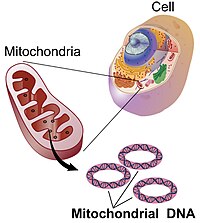
LRRK2 G2019S-induced mitochondrial DNA damage is LRRK2 kinase dependent and inhibition restores mtDNA integrity in Parkinson’s disease
Sign Up to like & getrecommendations! Published in 2017 at "Human Molecular Genetics"
DOI: 10.1093/hmg/ddx320
Abstract: Mutations in leucine-rich repeat kinase 2 (LRRK2) are associated with increased risk for developing Parkinson's disease (PD). Previously, we found that LRRK2 G2019S mutation carriers have increased mitochondrial DNA (mtDNA) damage and after zinc finger… read more here.
Keywords: lrrk2 g2019s; mtdna damage; kinase; damage ... See more keywords

Mitochondrial ROS-Modulated mtDNA: A Potential Target for Cardiac Aging
Sign Up to like & getrecommendations! Published in 2020 at "Oxidative Medicine and Cellular Longevity"
DOI: 10.1155/2020/9423593
Abstract: Mitochondrial DNA (mtDNA) damage is associated with the development of cardiovascular diseases. Cardiac aging plays a central role in cardiovascular diseases. There is accumulating evidence linking cardiac aging to mtDNA damage, including mtDNA mutation and… read more here.
Keywords: mitochondrial ros; mtdna damage; cardiac aging; target ... See more keywords

Targeting Mitochondrial Function with Chemoptogenetics
Sign Up to like & getrecommendations! Published in 2022 at "Biomedicines"
DOI: 10.3390/biomedicines10102459
Abstract: Mitochondria are ATP-generating organelles in eukaryotic cells that produce reactive oxygen species (ROS) during oxidative phosphorylation (OXPHOS). Mitochondrial DNA (mtDNA) is packaged within nucleoids and, due to its close proximity to ROS production, endures oxidative… read more here.
Keywords: damage; mitochondrial function; mtdna mutations; ros ... See more keywords

Age-associated decline in Nrf2 signaling and associated mtDNA damage may be involved in the degeneration of the auditory cortex: Implications for central presbycusis
Sign Up to like & getrecommendations! Published in 2018 at "International Journal of Molecular Medicine"
DOI: 10.3892/ijmm.2018.3907
Abstract: Central presbycusis is the most common sensory disorder in the elderly population, however, the underlying molecular mechanism remains unclear. NF-E2-related factor 2 (Nrf2) is a key transcription factor in the cellular response to oxidative stress,… read more here.
Keywords: mtdna damage; degeneration; central presbycusis; presbycusis ... See more keywords